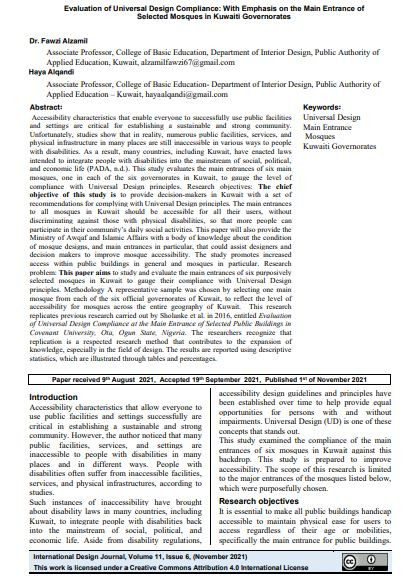
Accessibility characteristics that enable everyone to successfully use public facilities and settings are critical for establishing a sustainable and strong community. Unfortunately, studies show that in reality, numerous public facilities, services, and physical infrastructure in many places are still inaccessible in various ways to people with disabilities. As a result, many countries, including Kuwait, have enacted laws intended to integrate people with disabilities into the mainstream of social, political, and economic life (PADA, n.d.). This study evaluates the main entrances of six main mosques, one in each of the six governorates in Kuwait, to gauge the level of compliance with Universal Design principles.Research objectives: The chief objective of this study is to provide decision-makers in Kuwait with a set of recommendations for complying with Universal Design principles. The main entrances to all mosques in Kuwait should be accessible for all their users, without discriminating against those with physical disabilities, so that more people can participate in their community’s daily social activities. This paper will also provide the Ministry of Awqaf and Islamic Affairs with a body of knowledge about the condition of mosque designs, and main entrances in particular, that could assist designers and decision makers to improve mosque accessibility. The study promotes increased access within public buildings in general and mosques in particular. Research problem: This paper aims to study and evaluate the main entrances of six purposively selected mosques in Kuwait to gauge their compliance with Universal Design principles. Methodology A representative sample was chosen by selecting one main mosque from each of the six official governorates of Kuwait, to reflect the level of accessibility for mosques across the entire geography of Kuwait. This research replicates previous researchcarried out by Sholanke et al. in 2016, entitled Evaluation of Universal Design Compliance at the Main Entrance of Selected Public Buildings in Covenant University, Ota, Ogun State, Nigeria. The researchers recognize that replication is a respected research method that contributes to the expansion of knowledge, especially in the field of design. The results are reported using descriptive statistics, which are illustrated through tables and percentages.
I agree to the terms outlined below:
You agree to upload and assign Mosqpedia Database the rights to use the content worldwide and in perpetuity across all current and future media platforms. Mosqpedia Database may edit, copy, adapt and translate your contribution.
The content will be distributed under the Creative Commons Attribution-Deed – Attribution-NonCommercial-NoDerivatives 4.0 International – Creative Commons
All data will be stored in line with data protection regulations.